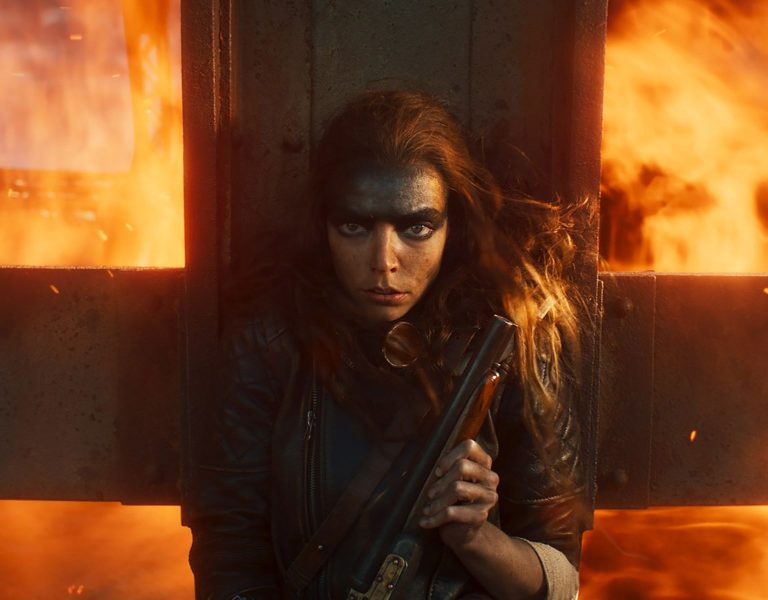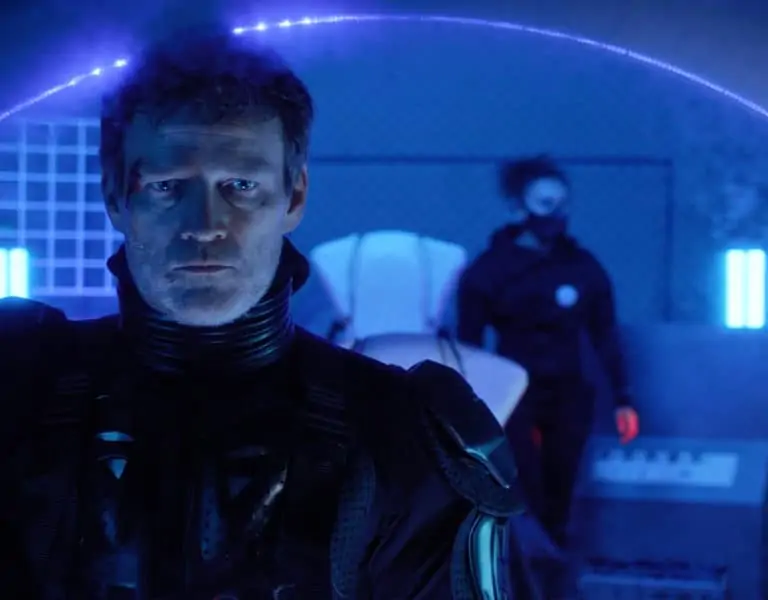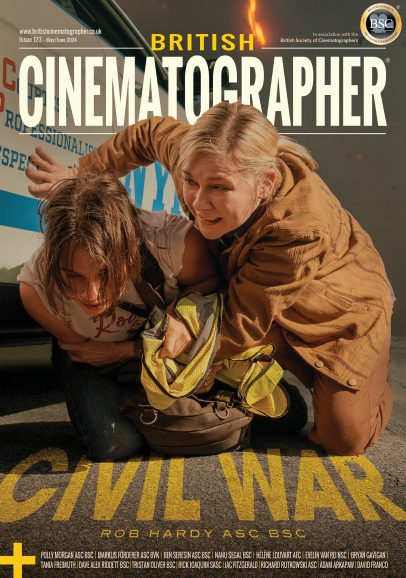
Furiosa: A Mad Max Saga is a 2024 post-apocalyptic film directed by George Miller. It is the fifth instalment in the Mad Max series and a prequel to Mad Max: Fury Road (2015).
Responsible for the colour on the latest instalment was Eric Whipp of alter ego, who worked on Baselight 6.0 across three locations: alter ego in LA and Toronto as well as Spectrum Films in Sydney, who handled the workflow supervision, conform, home entertainment mastering and delivery in Baselight.
Whipp, Miller and the Spectrum team worked together previously on Three Thousand Years of Longing (2022) and brought a similar workflow to Furiosa. Whipp and Miller also collaborated on Fury Road, but the director-colourist duo has worked together for nearly two decades.
“It’s been almost 20 years since the first film I did with George, which was Happy Feet, back in 2005,” says Whipp. “Since then, we’ve done five films together, and created a kind of shorthand. I have learned what type of image and style he likes, and at the same time, he’s challenged me further and further in the grade, knowing that I can most probably achieve whatever he’s looking for. Together, we’ve pushed the boundaries of what Baselight can do and embraced every little toolset we can find to help tell stories.”
Developing a workflow: Sydney
The work on the movie was spread across three different facilities and cities – starting with Spectrum Films, a family-owned and operated business in Sydney, Australia, who handled the conforming in Baselight in the same space as the editorial department.
“We started on the workflow for Furiosa while we were completing Three Thousand Years of Longing,” comments Michael Messih, technical operations manager at Spectrum. “The same on-set VFX supervisor worked on both films, so we were able to bring a lot of what we had developed in Baselight directly over to the Furiosa pipeline.”
“The Rebel Fleet managed the dailies and all the VFX pulls, and because there were so few shots which didn’t require visual effects we decided to do everything via EXR sequences,” explains Catherine Armstrong, general manager and head of post-production at Spectrum. “At no point did we actually see any of the original camera raw files.”
Andrew Cucé, colourist and finishing editor at Spectrum, commented: “The best feature we had was Baselight’s shot versioning tool. We would typically get up to 100 shots a day, so having the version refresh feature made things so much quicker. Also being able to switch back and compare versions during VFX reviews was amazing.”
Spectrum helped to develop a workflow for colour-critical 4K graded streams between LA and Sydney, and maintained a rigorous calibration check procedure – including colour comparisons and render tests – to ensure that everyone was seeing the same images.
“George likes to refer to the term ‘rolling DI’, implying a tight integration between departments which means that the grading process happens alongside all the VFX work,” explains Messih. “Having the remote working ability between Spectrum and alter ego meant that Eric didn’t have to spend weeks over in Sydney – and George could review everything from the 4K DI theatre at Spectrum.”
The Spectrum team worked entirely in ACES and made good use of Baselight’s ability to quickly switch between colour spaces to compare colour in different viewing conditions. It also supported quick switching of formats, which they were doing all the time to compare 4K, HD and UHD against the various references.
Supported by an incredible team of additional finishing editors (Affrica Handley and James Cowie) and production experts (Basia A’hern and Sofia Costa), the Spectrum team utilised the Baselight reporting tool, which allowed them to provide daily data reports and enable the VFX supervisor to cross-check versions.
“This was essential in Furiosa, as we were doing most of the VFX changes in Baselight rather than waiting for an updated EDL,” comments Armstrong. “DI was effectively leading the edit in the end, so this reporting tool was critical.”
“Due to the nature of Eric’s stacks, I ended up doing quite a lot of the editorial changes manually in the timeline,” adds Cucé. “The new Baselight 6.0 timeline editing tools will make this much easier – the addition of tracks and the ability to compress large stacks means managing a complex timeline will be a lot simpler for future projects like this.”
Colour: LA and Canada
alter ego opened its LA office in September 2023 and knew one of the first projects would be Furiosa.
“We ensured we had everything we needed to grade the film while building out the new office,” says Whipp. “A big part of this was to ensure that our six Baselight suites in Toronto could easily sync with the two new Baselight suites in LA.”
“We also needed to find a way to sync up the Baselight suites at Spectrum, so we set up a project server here at alter ego in LA, which everyone was connected to,” says Whipp. “This way, once a reel was conformed in Sydney, it was as easy as opening it in LA and everything was linked up.”
There was also a dedicated team of colour support at alter ego in Toronto and LA to assist with the large amount of roto requirements on the movie. This meant Whipp could spend more time on the look and some of the other complicated issues that came with this film.
“We had experts such as Andrew Ross, Lily Henry and James Graham working furiously (pun intended) on roto and shapes, with Jonah Venneri, Daniel Saavedra, Ben Otten and Corey Martinez all handling the terrabytes of data moving across the three facilities on a daily basis,” says Whipp.
“Colourist Andrew Ross was amazing to work with, helping me prepare scenes and some of the balancing work,” adds Whipp. “Some of the looks required layers of shapes and keyframing just to get started, so it really was a team effort.”
Colour producer Genna McAuliffe was managing and tracking all the shots and scenes and keeping track of the Baselight work in progress across the three facilities. In LA, Corey Martinez, who served as the lead colour assistant, helped to manage the immediate needs for each session and also supported with roto. Ben Otten was also on hand to help make AI mattes and other things as they came up.
“Towards the last couple of months on the film, it really did become a bit of a rush,” recalls Whipp. “I was grading until 3am (LA time – to sync with the time zone in Sydney), and back at it at 8am. There was just so much work to be done in Baselight, that having the three facilities on three different time zones actually worked out amazingly for us.”
Whipp graded the film almost entirely remotely and was delighted with the result.
“George was in Sydney, and I was in the alter ego LA office,” says Whipp. “We streamed the 4K image from LA to Spectrum Films, and the image looked flawless.”
Exploring look development in pre-production
Whipp began work on the movie around two years ago, completing grading tests as the shoot began, but the heavy work started towards the end of 2023.
“We went through a look development process first. These sessions were very important to getting the look right,” says Whipp. “George is very hands on with the grade and loves to sit in the Baselight suite and explore options, but I always tried to find a sweet spot before going into those sessions, to guide where we might go.”
“What’s great about working with George is, he’s not afraid to really push and go hard on certain things,” adds Whipp. “He loves a rich contrasty image, so it’s my job to try and deliver that look without it looking too cheap or too digital.”
Graphic novel look
As the film is a prequel, Whipp began by re-watching Fury Road to remind himself where they ended up.
“We knew it had to be similar, but not exactly the same,” says Whipp. “In Furiosa, we visit locations that are only talked about in Fury Road (like Gastown and the Bullet Farm). So the door was wide open for us to explore.”
For Gastown, for example, Whipp developed two looks – the first being a typical industrial site and the second, which comes years later after Dementus has run it into the ground, was much darker and “dirtier”.
“We also graded some shots to resemble a Renaissance painting, and overall the film is leaning toward a graphic novel look,” adds Whipp. “We didn’t use any specific references, but it was definitely inspired by paintings and graphic novels.”
Chromogen
Whipp utilised the Chromogen tool in Baselight 6.0 to support the development of the look for Furiosa.
“I jumped into Baselight 6.0 specifically to work with Chromogen,” explains Whipp. “I knew I needed rich-coloured sand and deep-blue skies in a lot of cases, so I made look strips in Chromogen that pushed the sand colour richer and deepened blue skies which twisted toward a nice cyan-blue colour. In some scenes we needed the greenery to pop, so I created look strips to open up the greens.”
In all, Whipp ended up making approximately 20 look strips that he used for different scenes.
“All of these helped with the overall look while not being too destructive to the overall image,” says Whipp. “I converted them all to look strips so I could slide the amount of ‘effect’ shot by shot. We graded this film in ACES, so there was no need for a show LUT; working with look strips essentially does the same thing anyway, but with the advantage that everything is colour space aware, which allowed for easy transitions to HDR and rec.709.”
“It was interesting to work with Chromogen on this film,” adds Whipp. “I’d take a scene, play with it in Chromogen and find a look that I felt was helping. But a day or two later, I’d find myself jumping back in to Chromogen to refine it. Then another scene would come along with a slightly different look, and I’d find that the Chromogen look I had just created two days ago was not going to work, so I’d jump back in and adjust it specifically for the new scene.
“Traditionally, I have never had that much control over a LUT. I’d have to grade around it. For example, I used this one LUT for years that I loved, but green colours were not very strong and in fact got twisted to yellow. So I’d often have to key green colours and bring them back over the LUT.
“With Chromogen, I can literally adjust something like that and save off a LUT that won’t require all that keying shot by shot.”
Elevating the image with Baselight
Whipp used all kinds of Baselight tools on the grade – from shapes, keys, working with embedded mattes from EXR sequences, optical flow retimes, compositing new skies and adding new elements.
“There was a shot or two in the film where one of the actor’s eyeline was slightly off,” explains Whipp. “It ended up making them look a touch cross-eyed, so we used the gridwarp tool to shift the eyeball position over and correct the issue.
“On other shots we added a lot of additional dust, smoke and fire in Baselight. We used flicker, and heat haze effects, lens flares, you name it. I even photographed a series of lens dirt elements that we could then use to composite over certain shots to add some grunge and realism if needed.”
“FilmLight support on this film was incredible, too,” adds Whipp. “We had a few moments where the technology was stumping us for whatever reason, but a quick call and things were solved and we moved on without missing a beat. That’s one of the reasons why we picked and continue to stay with Baselight.”
Heavy VFX
“As a lot of the backgrounds in this film are full CG, we would start with a basic lighting pass and comp of a shot from VFX, jump into the Baselight suite and play with the look,” explains Whipp. “Often we would try different skies and looks and sculpt the lighting to get it right for the scene.”
When Whipp had a look that George liked, he would send that reference back to the VFX teams to match the lighting and look. Then the shots would come back with the amended sky and lighting.
“We had a great collaboration with VFX on this film,” adds Whipp. “It’s imperative that we work together closely and support each other on huge projects like this.”
Andrew Jackson was the VFX supervisor, who Whipp had worked with on Fury Road.
“This is why colour was brought in so early,” explains Whipp. “Between colour and VFX, we could work out where the best place was to achieve a look. In many cases, we opted to do the effect or look in Baselight so that it could be adjusted to George’s preference, rather than bake it into the VFX comp.”
Whipp also found this was a great place to explore looks as they could take a shot and very quickly composite a new sky or add layers of dust or light rays to see what that did for the image.
“We did this for every scene to establish what the feel would be,” explains Whipp. “It makes it easier for VFX to move forward, as there’s a reference of where we need to end up. This is ultimately the way George loves to work. Traditionally, VFX would try out lighting looks and send them through for him to look at. He would give notes, wait a couple of days, and repeat the process until the VFX is sitting in a good place. But if we get these early VFX-passes into the Baselight suite, he can adjust and control the look in real time and find the desired look much faster.”
Challenges and highlights
Unlike Fury Road, which was shot on location in Namibia, Africa, Furiosa was shot in Australia (where the original 1979 Mad Max was filmed), so a lot of the background environments in Furiosa are CG.
This didn’t come without its challenges for Whipp, as the film still needed to look like the desert from Fury Road – hence the large VFX involvement.
“The weather wasn’t playing nicely once the shoot began, so there was a huge mix of sunny and cloudy days,” recalls Whipp. “At some points the wind was so strong on set, they had to move into a studio to shoot outdoor action scenes. So once the edit was done we ended up with a mix of sunny shots, overcast cloudy shots and studio-lit shots. Obviously they don’t all match seamlessly, so there was a lot of work in the Baselight suite to even these out and relight as best we could.”
The CG backgrounds required specific work, too, to prevent them from looking too perfect and crisp.
“We did a lot of depth hazing in the grade, to reduce some of the contrast and help draw your eye to the main action taking place, and lots of other tricks in the grade to take away some of the CG edge,” explains Whipp.
One of the most challenging sequences for Whipp was a section they called the “war montage”.
“It involved a series of shots that dissolved and overlaid on top of each other,” explains Whipp. “That alone would be quite a task, to bring through certain parts of the image via a dissolve and get the timing perfect. But we took it up a notch and also composited new backgrounds into each shot and added layers and layers of fire, smoke, embers and ash flying across the frame. A huge amount of compositing work and roto work was required in Baselight to get that little sequence working.”
When asked about his highlight on this project, Whipp struggled to single out a scene, sequence or look.
“There’s certainly scenes that I prefer the look of over others,” he said, “But George once told me that people often ask him what his favourite shot is. He said it’s like asking a composer to tell you their favourite note. It’s the combination of all of the notes that makes the music. I feel very similar about colour. If the story is being told well, and the images look rich and graphic, then we must have done our job right.”
Furiosa: A Mad Max Saga had its worldwide premiere at the Cannes Film Festival on May 15, before its UK premiere in London on Friday May 17. The film was released in cinemas on May 24 globally.














